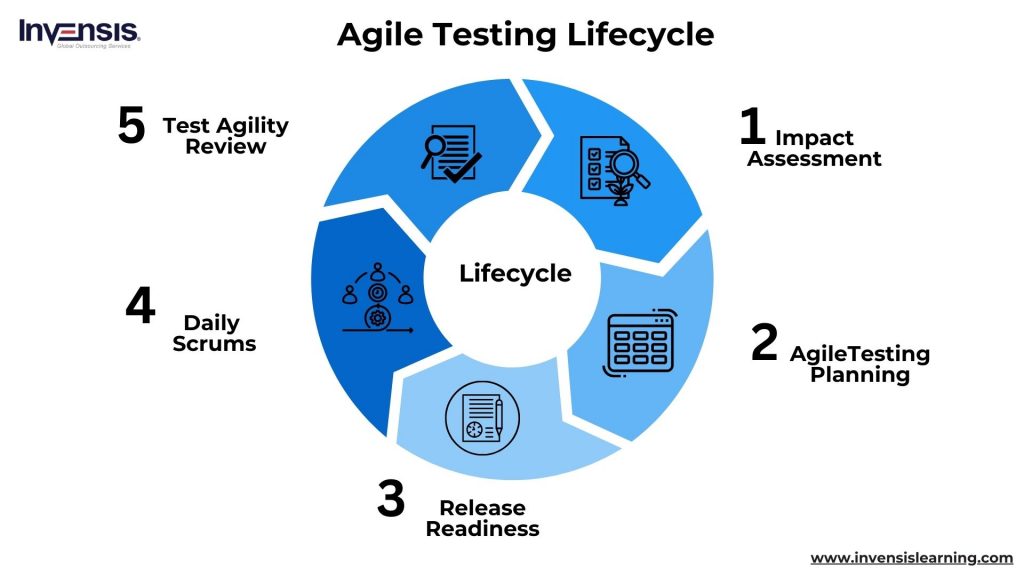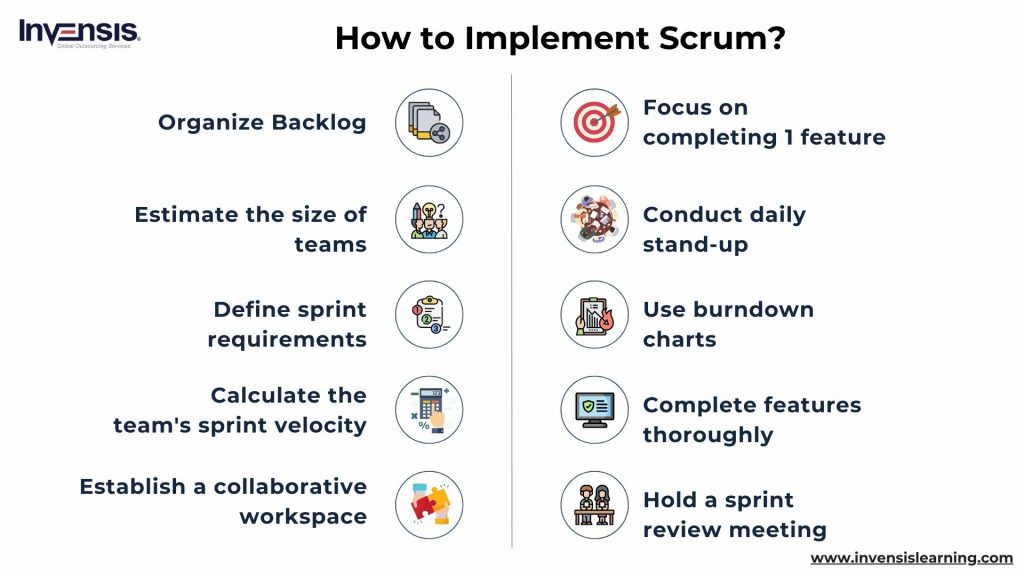
Agile methodology continues to dominate the software development landscape. This blog is curated to keep you abreast with the most pertinent and up-to-date interview questions in Agile Testing, ensuring you stay ahead in this dynamic field.
Whether you’re a job seeker aiming to nail your next interview, a recruiter seeking the ideal candidate, or simply a curious learner, this resource is your gateway to mastering Agile testing.
From fundamental concepts to advanced techniques, we cover a spectrum of questions that mirror the current trends and demands of the industry.
Table of Contents:
- Agile Testing Interview Questions for Freshers
- Agile Testing Interview Questions for Experienced
- Conclusion
Agile Testing Interview Questions for Freshers
This section is a targeted guide designed for those embarking on their journey in the Agile Testing world. This section serves as a crucial stepping stone for fresh graduates and newcomers in the software Testing arena, offering a collection of essential interview questions that encapsulate the basics and nuances of Agile Testing.
-
What is Agile Testing?
Agile Testing is a dynamic approach integrated into the Agile software development process. It emphasizes continuous collaboration between development and testing teams from the project’s inception.
This approach differs from traditional methods by being iterative rather than sequential, meaning testing occurs alongside development, not just after complete coding.
Agile Testing aims to quickly identify and resolve errors, enhancing the product with each release.
This method ensures a high-quality product and fosters customer satisfaction by focusing on rapid, efficient error resolution and a customer-centric delivery approach.
-
Describe the Agile Testing life cycle.
The Agile Testing life cycle deviates from traditional models by adopting an iterative approach, enhancing flexibility and responsiveness.
It encompasses five key phases:
- Impact Assessment: A critical phase where testers gather essential information from all project stakeholders
- Agile Testing Planning: Collaboration between stakeholders and testers to plan the testing process and outcomes
- Release Readiness: Evaluation of features to ensure they meet client expectations and are ready for deployment
- Daily Scrums: Regular meetings to discuss Testing progress and set daily objectives
- Test Agility Review: The final phase where stakeholders meet to review project progress and assess if goals have been met
-
What is Agile methodology in software development? Write Its types
Agile methodology in software development refers to an iterative approach that prioritizes delivering value to customers efficiently and promptly. It contrasts traditional methodologies by delivering work in small, manageable stages, facilitating rapid adaptation to change.
This approach adheres to the Agile Manifesto’s principles and values. Agile methodologies include Scrum, Kanban, Lean, Extreme Programming (XP), and Feature-Driven Development (FDD), each with unique characteristics but sharing the core Agile principles.
-
What are epics, user stories, and tasks?
- Epic: An epic is a large, broad feature or requirement detailed in the product backlog, typically broken down into smaller user stories
- User Stories: User Stories are concise, client-focused descriptions outlining a specific project or business function targeted for completion in a particular sprint
- Task: Tasks are the more granular components of user stories, further breaking down the story into actionable items
-
List the pros and cons of exploratory testing and scripted testing
| Testing Type | Pros | Cons |
|---|---|---|
| Exploratory Testing | Requires minimal preparation; Adapts easily to changes; Effective with limited documentation | Challenging to demonstrate progress and coverage |
| Scripted Testing | Ideal for compliance with legal/regulatory requirements | Time-intensive preparation; Redundancy in testing steps; Difficult to adapt to changes |
-
What is an Agile test plan?
An Agile test plan is a critical document outlining various testing activities within an iteration, including test data needs, environments, infrastructure, and results. It’s updated for each release in an Agile framework.
-
What are the key components of an Agile Test plan?
Key components of an Agile Test Plan include:
- Testing Scope: Outlining the extent and limits of testing
- Test Criteria: Including test requirements, sprint goals, and task specifics
- New Features Testing: Focusing on newly added functionalities
- Testing Levels: Determining the complexity-based testing types
- Performance and Load Testing: Assessing the system’s handling of workloads
- Infrastructure Considerations: Addressing the required testing infrastructure
- Risk Mitigation Plans: Strategies to minimize potential risks.
- Resource Management: Allocation of necessary resources.
- Milestones and Deliverables: Defining significant progress points and expected outcomes
-
What are the principles of Agile Testing?
Agile Testing is founded on eight main principles:
- Continuous Testing: Ensuring ongoing product improvement by testing alongside development
- Ongoing Feedback: Focused on quality to meet business objectives
- Whole Team Participation: Involving developers, business analysts, and testers in testing
- Rapid Feedback: Engaging business teams for swift feedback and error correction in each iteration
- Code Quality: Regular testing to maintain code integrity and address issues promptly
- Minimal Documentation: Employing reusable checklists over extensive documents
- Test-Driven Approach: Implementing testing during development
- Client Satisfaction: Allowing clients to observe and adapt the product’s evolution, aligning test processes with current needs
-
Explain the roles and responsibilities of Agile Testers
Agile testers have diverse responsibilities, including:
- Developing and updating Agile test strategies
- Reporting on test coverage
- Efficient use of testing tools
- Setting up and managing test environments
- Executing automated tests and reporting outcomes
- Identifying and resolving defects collaboratively
- Training and coaching team members
- Planning testing activities for releases and iterations
- Ensuring test requirements are clear, consistent, and complete
- Active involvement in team meetings and sessions
- Proposing and implementing improvements
- Tracking new Agile metrics like velocity and burndown charts
-
What are the Characteristics of a good Agile Tester?
An effective Agile tester should exhibit qualities such as:
- Alignment with company goals and mission
- Effective communication of project ideas
- Deep understanding of requirements and associated risks
- Prioritizing work based on evolving requirements
- Strong collaboration skills with business associates and developers
- Keen understanding of testing outcomes
- Proficiency in coding
- Analytical skills for enhancing testing methods
- Clarity and conciseness in information presentation
-
When should we use Agile Scrum methodology?
Agile Scrum Methodology is particularly suitable in scenarios such as:
- Unclear Client Requirements: Ideal when the client is unsure about their exact needs
- Rapid Delivery Expectations: When the client anticipates a swift product delivery
- Evolving Requirements: Suitable for projects where the client provides requirements incrementally
- Frequent Changes: Beneficial for projects with regularly changing or evolving requirements
-
Explain how you can measure the velocity of the sprint with varying team capacity.
To measure the sprint velocity, especially when team capacity varies, you can apply two methods:
- Method One: Multiply the completed story points by the team capacity, considering capacity as a percentage of a standard 40-hour week
- Method Two: Divide the completed story points by the team capacity, where capacity is measured in person-hours. This method is more applicable when precise person-hour capacity measurement is needed
-
What is a sprint in Agile methodology?
In Agile methodology, a sprint is a set, short duration during which the team aims to complete a defined amount of work or deliverables. Sprints form the core of scrum and Agile methodologies, typically lasting only one month.
Depending on their workflow and objectives, teams may choose different sprint durations, such as two-week or one-week sprints.
-
Explain what spike and zero sprints are in Agile. What is the purpose of each?
- Sprint Zero: This initial sprint is used for preparatory activities at the project’s outset. Common tasks during Sprint Zero include setting up the development environment, preparing the product backlog, and other groundwork necessary for the project’s success
- Spikes: These are special stories focused on research, exploration, design, or prototyping tasks. Spikes can be included between sprints to address technical or design challenges. They are categorized into two types: Technical Spikes for technology-related inquiries and Functional Spikes for user-centric or functionality-related research
-
What are Agile story points?
Agile story points serve as a metric to gauge the complexity of implementing a user story, reflecting the corresponding level of effort required. These points are indicative of the story’s difficulty, taking into account factors like risks, complexities, and efforts.
A higher number of story points signifies a greater level of effort. A commonly used method for estimating story points in Agileis the Fibonacci sequence, where each number is the sum of the preceding two. The sequence begins with 0, 1, 1, 2, 3, 5, 8, 13, 21, 34, 55, 89, and so on, providing a relative scale for story complexity.
Agile Testing Interview Questions for Experienced
In this section, we delve deeper into Agile Testing, specifically tailored for those with prior experience in the field. These questions are designed to challenge and expand your knowledge, ensuring you are well-prepared to excel in the Agile Testing role that demands higher expertise.
-
How should a tester approach continuously changing requirements?
When dealing with continuously changing requirements, an Agile tester should adopt the following strategies:
- Craft generic test plans and cases focusing on the intent of the requirement rather than its specific details
- Collaborate closely with product owners or business analysts to comprehend the scope of changes
- Ensure the team comprehends the risks associated with changing requirements, especially towards the end of a sprint
- Consider delaying test automation until the feature stabilizes and requirements are finalized
- Minimize changes by negotiating or implementing them in the next sprint
-
Explain velocity in Agile methodology.
Velocity in Agile methodology quantifies the work a team can accomplish during an iteration, serving as a crucial metric for accurate project timeframes. It is a straightforward calculation that measures the quantity of work completed within a specific timeframe. Various work units, such as story points, user stories, or engineer hours, can be used to measure this progress.
-
Distinguish between incremental and iterative development in Agile.
- Iterative Development: It involves continuous software development cycles, including sprints and releases, until the final product is achieved. For example, Release 1 comprises Sprints 1, 2, and so on, while Release N continues with Sprint 1, 2, and so forth
- Incremental Development: This approach divides the system functionality into segments or increments. Each increment delivers a portion of functionality through cross-discipline work, covering requirements to deployment
-
Why are daily stand-up meetings important in Agile?
Daily stand-up meetings are a cornerstone of Agile project management, fostering effective communication and collaboration within the team.
They hold significance for several reasons:
- Facilitate real-time communication among team members, enhancing agility
- Clarify roles and responsibilities, preventing organizational silos
- Address daily challenges and adapt to changes promptly
- Promote a sense of shared goals and objectives among team members
- Encourage knowledge transfer within the organization
-
What are the differences between RUP (Rational Unified Process) and Scrum Methodologies?
- RUP (Rational Unified Process)
-
-
- Follows a formal cycle across four phases, with some concurrent workflows
- Utilizes a formal project plan associated with multiple iterations
- The scope is predefined and documented in a scope document, subject to revision
- It involves artifacts like scope documents, formal functional requirements, architecture documents, etc.
- Recommended for long-term, large, and complex enterprise-level projects
-
- Scrum
-
- Operates in short cycles, with each sprint being a complete cycle
- Lacks an end-to-end project plan, with iteration planning determined at the end of each cycle
- Relies on a project backlog instead of a predefined scope
- Emphasizes operational software as the primary artifact
- Suited for quick enhancements and organizations less dependent on fixed deadlines
-
What is Scrumban in Agile?
Scrumban is an Agile methodology that combines the principles of Scrum and Kanban. By merging Scrum’s structured approach with Kanban’s flow-based methods, Scrumban allows teams to adapt to changing requirements and stakeholder needs while maintaining efficiency. This hybrid approach enhances team agility, productivity, and responsiveness.
-
What are the Agile quality strategies?
Agile quality strategies encompass various practices, including:
- Refactoring
- Non-solo development
- Static and dynamic code analysis
- Reviews and Inspection
- Iteration/sprint demos
- All hands demo
- Lightweight milestone reviews
- Short feedback cycles
- Standards and guidelines
-
Explain refactoring.
Refactoring refers to improving code or components’ internal structure, functionality, or readability without altering their external behavior. In Agile development, teams continually enhance and maintain their code incrementally to ensure good code quality, such as complex dependencies, excessive responsibilities per method, improper class design, and confusion. Refactoring simplifies complex code, leading to better maintainability and quality.
-
How can you implement Scrum in your project easily?
To implement Scrum effectively in your project, consider these steps:
- Organize and prioritize your backlog
- Estimate the size of product backlog items
- Define sprint requirements and duration for the sprint backlog
- Calculate the team’s sprint capacity and break down requirements into tasks
- Establish a collaborative workspace for discussions, plans, and updates
- Focus on completing one feature before moving on to the next during sprints
- Conduct daily stand-up meetings to track progress
- Use burndown charts to monitor sprint progress
- Complete features thoroughly before starting new ones
- Hold a sprint review meeting at the end to assess achievements
-
Explain spike and zero sprint in Agile.
- Sprint Zero: Sprint Zero serves as the initial sprint before the formal start of the project. It involves preparatory work, such as setting up the project environment, creating a skeleton, and conducting initial research. It answers fundamental questions about the project’s duration, tools, and work methods.
- Spike: A Spike, often called a “spike solution,” is a brief investigation or research phase in Agile. It aims to better understand a task’s scope or technical challenges by constructing a quick, throwaway solution. Spikes help teams validate technical assumptions and make informed decisions about upcoming work.
-
What is a test stub in Agile?
In Agile, a test stub is a small piece of code or module simulating a component within the tested system. Test stubs are used in top-down integration testing to replace lower-level modules that still need integration.
They mimic the behavior of these modules, producing the same output as the actual product. Test stubs facilitate testing and validation when complete components are unavailable or under development.
-
What is Application Binary Interface (ABI)?
Application Binary Interface (ABI) is a term in computer software that refers to an interface between two binary program modules. One module can be a library or system facility, while the other is a user program.
ABI delves into the implementation details of programs, encompassing aspects such as the code’s transformation post-compilation.
It encompasses elements like calling conventions, data types, alignment, size, and how an application should interact with system calls to the operating system.
-
Explain the importance of Continuous Integration (CI) in Agile.
Continuous Integration (CI) is a fundamental aspect of Agile development. This practice involves continuously integrating small code components into the main codebase throughout the software development lifecycle (SDLC).
The significance of CI in Agile is evident through the following benefits:
- Facilitates easy enhancement of new features after the initial release
- Reduces development time for new features while maintaining product stability
- Promotes frequent feedback between developers and stakeholders, ensuring correctness before iteration deadlines
- Combining Agile with continuous integration transforms the SDLC, making it more efficient and rapid
- Effective CI ensures that integration challenges are minimized as code deviations from the base are small, simplifying the development process
-
What qualities should a Good Agile Tester possess?
A proficient Agile tester should exhibit the following qualities:
- Quick comprehension of requirements
- Thorough understanding of Agile principles and concepts
- Ability to assess and manage risks associated with changing requirements
- Skill in prioritizing work based on requirements
- Effective communication with business associates, developers, and team members
-
How can QA benefit an Agile team?
Quality Assurance (QA) analysts contribute significantly to Agile teams in the following ways:
- Early identification of potential risks due to close collaboration with the development team
- Providing testing effort estimates during sprint planning sessions
- Acting as a proxy product owner when necessary and discussing business requirements with the Product Owner
- Offering feedback to the Product Owner for continual improvement of user stories
- Participating in quick handoff demonstrations with developers to understand and question newly developed features, ensuring quality
Conclusion
Agile Testing offers promising career opportunities for individuals seeking employment in leading organizations. However, success in this field requires dedication and consistent effort. Agile Testing fosters close collaboration between developers and testers, elevating the overall software quality.
Whether you’re an experienced professional or new to the field, mastering the Agile interview questions mentioned above will propel you to the forefront of your career. Confidence and preparation, including mock interviews, are key to your success. You can excel in your Agile Testing interviews with thorough preparation and a strategic approach.
Ready to boost your Agile Testing skills and excel in interviews?
Take our Agile Certification Courses to enhance your knowledge and expertise in this dynamic field. Prepare yourself for a rewarding career in Agile Testing today!
















